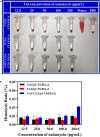Fabrication and Characterization of Chitosan/Poly(Lactic-Co-glycolic Acid) Core-Shell Nanoparticles by Coaxial Electrospray Technology for Dual Delivery of Natamycin and Clotrimazole
- PMID: 33748084
- PMCID: PMC7973235
- DOI: 10.3389/fbioe.2021.635485
Fabrication and Characterization of Chitosan/Poly(Lactic-Co-glycolic Acid) Core-Shell Nanoparticles by Coaxial Electrospray Technology for Dual Delivery of Natamycin and Clotrimazole
Abstract
Natamycin (NAT) is the drug of choice for the treatment of fungal keratitis (FK). However, its inherent shortcomings, such as poor solubility, high dosing frequency, and long treatment cycle, need to be urgently addressed by designing a new delivery to widen its clinical utility. Growing research has confirmed that clotrimazole (CLZ) plays a significant role in fungal growth inhibition. Hence, coaxial electrospray (CO-ES) technology is used herein to prepare nano-systems with an average hydrodynamic particle size of 309-406 nm for the co-delivery of NAT and CLZ in chitosan (CTS) and poly(lactic-co-glycolic acid) (PLGA). The resulting NAT/CLZ@CTS/PLGA formulations were characterized by a transmission electron microscope (TEM) and in vitro release test. The results show that the formulations had obvious core-shell structures, uniform particle distribution, and also can sustain the release of drugs over 36 h. Furthermore, in vitro hemolysis, in vivo corneal irritation test, local allergenic test, and antifungal activity analyses are performed to evaluate the safety and efficiency of the formulations. Thus, good biosafety along with a significant anti-candidiasis effect are found in the NAT/CLZ@CTS/PLGA nanoparticles (NPs). Taken together, the results suggest that this design may provide a promising drug delivery system and a new option for the treatment of FK.
Keywords: C. albicans; clotrimazole; coaxial electrospray; core-shell structure; natamycin.
Copyright © 2021 Cui, Li, Xu, Guan, Ma, Ding and Zhang.
Conflict of interest statement
The authors declare that the research was conducted in the absence of any commercial or financial relationships that could be construed as a potential conflict of interest.
Figures








Similar articles
-
Macrophage Membrane-Coated Nanoparticles for the Delivery of Natamycin Exhibit Increased Antifungal and Anti-Inflammatory Activities in Fungal Keratitis.ACS Appl Mater Interfaces. 2024 Nov 6;16(44):59777-59788. doi: 10.1021/acsami.4c11366. Epub 2024 Oct 28. ACS Appl Mater Interfaces. 2024. PMID: 39467057
-
Thermosensitive Tri-Block Polymer Nanoparticle-Hydrogel Composites as Payloads of Natamycin for Antifungal Therapy Against Fusarium Solani.Int J Nanomedicine. 2022 Mar 28;17:1463-1478. doi: 10.2147/IJN.S332127. eCollection 2022. Int J Nanomedicine. 2022. PMID: 35378880 Free PMC article.
-
Platelet membrane-camouflaged PLGA loaded natamycin improve the prognosis of fungal keratitis.Biomater Adv. 2025 Jul;172:214239. doi: 10.1016/j.bioadv.2025.214239. Epub 2025 Feb 22. Biomater Adv. 2025. PMID: 39999534
-
PLGA Core-Shell Nano/Microparticle Delivery System for Biomedical Application.Polymers (Basel). 2021 Oct 10;13(20):3471. doi: 10.3390/polym13203471. Polymers (Basel). 2021. PMID: 34685230 Free PMC article. Review.
-
Coaxial Electrohydrodynamic Atomization for the Production of Drug-Loaded Micro/Nanoparticles.Micromachines (Basel). 2019 Feb 14;10(2):125. doi: 10.3390/mi10020125. Micromachines (Basel). 2019. PMID: 30769856 Free PMC article. Review.
Cited by
-
Assessment of structural, biological and drug release properties of electro-sprayed poly lactic acid-dexamethasone coating for biomedical applications.Biomed Eng Lett. 2021 Sep 3;11(4):393-406. doi: 10.1007/s13534-021-00205-9. eCollection 2021 Nov. Biomed Eng Lett. 2021. PMID: 34616584 Free PMC article.
-
Sustainable Synthesis of Multifunctionalized Amoxicillin-Loaded Biopolymer Foams.ACS Omega. 2025 Apr 11;10(15):15525-15539. doi: 10.1021/acsomega.5c00442. eCollection 2025 Apr 22. ACS Omega. 2025. PMID: 40290945 Free PMC article.
-
Topical Ocular Drug Delivery: The Impact of Permeation Enhancers.Pharmaceutics. 2025 Mar 31;17(4):447. doi: 10.3390/pharmaceutics17040447. Pharmaceutics. 2025. PMID: 40284442 Free PMC article. Review.
-
Three-Dimensional-Printed GelMA-KerMA Composite Patches as an Innovative Platform for Potential Tissue Engineering of Tympanic Membrane Perforations.Nanomaterials (Basel). 2024 Mar 23;14(7):563. doi: 10.3390/nano14070563. Nanomaterials (Basel). 2024. PMID: 38607098 Free PMC article.
-
pH-Activated Nanoplatform Derived from M1 Macrophages' Exosomes for Photodynamic and Ferroptosis Synergistic Therapy to Augment Cancer Immunotherapy.Biomater Res. 2025 Mar 6;29:0153. doi: 10.34133/bmr.0153. eCollection 2025. Biomater Res. 2025. PMID: 40051791 Free PMC article.
References
LinkOut - more resources
Full Text Sources
Other Literature Sources
Research Materials

